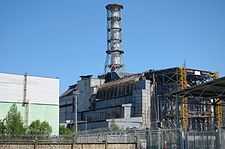TORCH report
The TORCH report (The Other Report on Chernobyl) was requested by the European Greens in 2006, for the twentieth anniversary of the Chernobyl disaster, in reply to the 2006 report of the Chernobyl Forum which was criticized by some advocacy organizations opposed to nuclear energy such as Greenpeace.
In 2006, German Green Member of the European Parliament Rebecca Harms, commissioned two British scientists to write an alternate report (TORCH, The Other Report on Chernobyl) as a response to the 2006 Chernobyl Forum report. The two British scientists that published the report were Dr. Ian Fairlie, who had published a number of papers dating back to at least 1992[1] and Dr. David Sumner. Both are members of the International Physicians for the Prevention of Nuclear War, an organization awarded the Nobel Peace Prize in 1985.[2][3]
Contamination range
The TORCH Report stated that:
"In terms of their surface areas, Belarus (22% of its land area) and Austria (13%) were most affected by higher levels of contamination. Other countries were seriously affected; for example, more than 5% of Ukraine, Finland and Sweden were contaminated to high levels (> 40,000 Bq/m² caesium-137). More than 80% of Moldova, the European part of Turkey, Slovenia, Switzerland, Austria and the Slovak Republic were contaminated to lower levels (> 4000 Bq/m² caesium-137). And 44% of Germany and 34% of the UK were similarly affected." [4]
Iodine and thyroid effects
The TORCH 2006 report "estimated that more than half the iodine-131 from Chernobyl [which increases the risk of thyroid cancer] was deposited outside the former Soviet Union. Possible increases in thyroid cancer have been reported in the Czech Republic and the UK, but more research is needed to evaluate thyroid cancer incidences in Western Europe". It predicted about 30,000 to 60,000 excess cancer deaths and warned that predictions of excess cancer deaths strongly depend on the risk factor used; and predicted excess cases of thyroid cancer range between 18,000 and 66,000 in Belarus alone depending on the risk projection model [5]
Health effects other than cancer
The TORCH report also stated that "two non-cancer effects, cataract induction and cardiovascular diseases, are well documented with clear evidence of a Chernobyl connection." Quoting the report, Nature wrote that: "it is well known that radiation can damage genes and chromosomes"; "the relationship between genetic changes and the development of future disease is complex and the relevance of such damage to future risk is often unclear. On the other hand, a number of recent studies have examined genetic damage in those exposed to radiation from the Chernobyl accident. Studies in Belarus have suggested a twofold increase in the germline minisatellite mutation rate".[6][7]
See also
- Chernobyl disaster
- Chernobyl disaster effects
- List of Chernobyl-related articles
- Nuclear power debate
References
- ↑ http://www.ianfairlie.org/publications/ .
- ↑ http://ippnw.org/nobel-peace-prize.html
- ↑ http://www.nobelprize.org/nobel_prizes/peace/laureates/1985/
- ↑ "TORCH report executive summary" (PDF). European Greens and UK scientists Ian Fairlie PhD and David Sumner. April 2006. Retrieved 2006-04-21.
- ↑ TORCH report executive summary, op.cit., p.4
- ↑ "Special Report: Counting the dead". Nature. April 19, 2006. Retrieved 2006-04-21.
- ↑ Concerning human minisatellite mutation rate after the Chernobyl accident, the Nature April 2006 article also quotes Yuri E. Dubrova, Valeri N. Nesterov, Nicolay G. Krouchinsky, Valdislav A. Ostapenko, Rita Neumann, David L. Neil & Alec J. Jeffreys (April 25, 1996). "Human minisatellite mutation rate after the Chernobyl accident". Nature n° 380. Retrieved 2006-04-21.
External links
- "TORCH report executive summary" (PDF). European Greens and UK scientists Ian Fairlie PhD and David Sumner. April 2006. Retrieved 2006-04-21.
| ||||||||||||||||||||||||||||||||||||||||||||
